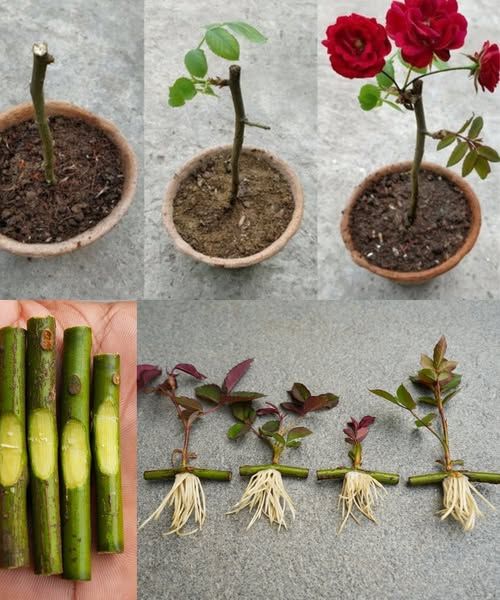ADVERTISEMENT
Step-by-Step Instructions
1. Select the Perfect Cutting
- Choose a healthy, disease-free rose stem about 6–8 inches long.
- Look for stems that are semi-hardwood (firm but still slightly green).
2. Prepare the Cutting
- Cut the stem at a 45-degree angle just below a node (the bump where leaves or flowers emerge).
- Remove the lower leaves, leaving only 2–3 at the top.
- Trim any flowers or buds to direct the plant’s energy toward rooting.
3. Dip in Rooting Hormone
- Dip the cut end of the stem into rooting hormone to promote faster root development.
- Tap off any excess powder or gel.
4. Plant the Cutting
- Fill a small pot with a well-draining potting mix.
- Use a pencil or your finger to create a hole in the soil, then insert the cutting about 2–3 inches deep.
- Firmly press the soil around the cutting to secure it.
5. Create a Mini Greenhouse
- Cover the pot with a plastic bag or dome to create a humid environment.
- Ensure the plastic doesn’t touch the cutting by using sticks to prop it up if necessary.
6. Water and Place
- Mist the cutting with water using a spray bottle.
- Place the pot in a bright spot with indirect sunlight. Avoid direct sun, which can dry out the cutting.
7. Monitor and Maintain
- Keep the soil moist but not soggy.
- Mist the cutting regularly to maintain humidity.
Signs of Success
After 4–8 weeks, you may notice:
- New growth or leaves appearing.
- Gentle resistance when you tug on the cutting, indicating root development.
Once the cutting has established roots, it’s ready to be transplanted into a larger pot or directly into your garden.
Tips for Growing Roses from Cuttings
- Use Healthy Parent Plants: Start with vigorous, disease-free stems.
- Sterilize Tools: Clean pruning shears and knives to prevent infections.
- Patience is Key: Some cuttings may take longer to root than others.
- Protect from Frost: For fall cuttings, keep pots indoors or in a sheltered location.
Growing Roses: A Symbol of Care
Propagating roses from cuttings is a labor of love that results in flourishing plants and beautiful blooms. By following these steps and providing the right care, you can enjoy your favorite roses in multiple areas of your garden or share them with loved ones as gifts.
With a little effort and patience, you’ll create a legacy of roses that continues to thrive for years to come. Happy gardening!
ADVERTISEMENT
ADVERTISEMENT
